For many people, their lifelong dream is owning a Colorado cattle ranch. The mystique of rounding up the cattle in the fall to bring them back to the home place is very powerful. The idea of saddling up a good horse to ride through the mountains checking the herd, or branding the calves in the spring—well, that’s as good as it gets.
The Seasons of Colorado Cattle Ranching
However, there’s a lot of hard work and aggravation that goes into cattle ranching, and many people don’t understand just what it entails. To understand how most mountain cattle ranches operate, you have to look at the seasons of the year.
Spring can be both wonderful and brutal in the Rockies, with blinding snowstorms one day and soft, lovely sunshine the next. Most Colorado ranchers grow hay on their property, which is baled and stored to feed the animals through the winter and early spring. The herds graze on the hayfields over the winter and clean up the remaining stubble if the snow isn’t too deep.
The Importance of a “Balanced Ranch”
Once the growing season begins, it’s every rancher’s goal to get those cows off the hayfields so that he can start irrigating and growing hay again. Many ranchers that have dryland pastures use these fields for spring pasture, either grazing on the grass that comes up or feeding hay. Over the summer, the ranchers must either move their cows to the high country to graze on national forest or BLM property, or to private property in the mountains. If you’ve ever been mountain biking or jeeping in the mountains and come across a herd of cattle in a mountain meadow, that’s what is going on. Grazing permits are highly coveted, and usually sell at a premium when they come available. Buying or selling a grazing permit can be a complex deal, because the US Forest Service insists that a special use permit on the National Forest, whether a grazing permit, outfitting permit, or some other permit, cannot be bought and sold. As with thousands of other perplexing positions of the U.S. government, that is basically not true. Grazing permits are bought and sold all the time. However, they insist that the permit is based on the value of the CATTLE, not the permit, so on almost every occasion, buyers are forced to purchase the stock of the seller, at an inflated price that reflects the value of the permit plus the value of the stock. So, as one rancher recently told me, “Yeah, I can buy that permit, but I’ll end up with a bunch of old broke-mouth cows that will have to be shipped a year after we buy the permit.”
Grazing permits are allotted to ranchers who are given a certain number of “animal units”, usually cow/calf pairs, that can graze on the rich grasses of the national forest. Grazing permits are limited in number, and are bought and sold like leases on commercial property. Prices for grazing permits can vary from $50,000 to much, much more, depending on the location, the quality of the forage, the difficulty of the terrain, and the number of animals it can carry. Very rarely are grazing permits “open”, or unallocated, and able to be picked up for only the application fee. Ranchers pay a fairly nominal amount to the U.S. Forest Service or to the Bureau of Land Management to graze their cattle on public lands—usually only a few dollars per “animal unit” per month. Before you think the ranchers are getting a great deal at the public’s expense, factor in the costs of maintaining the allotment—groceries and salary for the pool rider, propane for the cabin, fencing materials, salt, clearing trails, and fuel.
Many ranchers resort to buying high-country grazing land to support their herds during the summer. These lands are usually in a transition zone between real “high country”–properties above 10,000 feet–and the ranches on the valley floor. These types of properties are usually in the 6,500-8,500 foot zone in elevation, with sagebrush meadows, grassy meadows, oak brush, aspen groves, and sometimes pine forests. These lands are usually accessible only in the summer by vehicle or in the winter by snowmobile or ATV. Often the hunting is very good on these properties, and there is competition for the ranching buyer from sportsmen and speculators. However, having a good place to take the cows in the summer can make a big difference in the success of a good working cattle ranch–it’s part of what we call a “balanced ranch”. If you think you want to buy a Colorado cattle ranch, you’d better have good representation, because not many brokers understand all the aspects of what it takes to make a good balanced ranch.
Branding, Castrating, and Ear-tagging–making Sure “Who Is Whose”
Prior to driving the cows up to the high country, however, the calves must be branded for identification purposes and the bull calves to be raised for slaughter must be castrated to make steers out of them. If the calves are growing horns, the horns are burned out of their heads, and they’re vaccinated as well. It’s a tough day if you’re a young bull calf. This is a hot, dusty, noisy, smoky affair, and a time when people pitch in to help each other with a hard day’s work. Some ranchers rope the calves and drag them to a fire, while others run them through a squeeze chute to accomplish the task. Most ranchers use propane torches to keep the branding irons hot—the days of wood fires and hot coals are pretty much over. A branding is seen as a big social affair, with neighbors and friends coming from all around to join in the work.. Though a branding is a lot of fun, it is indeed work. It is the essence of a valued tradition of horsemanship, animal husbandry, and a social connection. Cowboys love to rope, and there’s nothing like getting a good horse saddled and catching a couple dozen calves and dragging them to the “muggers”, the guys and gals who have signed up to hold the calves down while another brands them and yet another de-nuts them. If you think you’re tough, try throwing a big 400-pound bull calf to the ground and hold him still while he gets a red-hot iron slapped on his flanks and then gets his nuts cut off. You might not be as tough as you think. You will certainly be tired and sore after the day is over. Though every cowboy loves to rope, as a matter of etiquette, the host of a branding not only buys all the beer, burgers, and lunch fixings, he doesn’t rope, either. That pleasure is left to his neighbors, who have volunteered their horses and labor for the day. After all, the days of cattle rustling are not over. Though Colorado has fairly strict brand laws, other states do not, and it’s not unheard-of for a bunch of cattle to disappear from a mountain pasture. Gone. Brands and eartags really help to track them. As one old cowboy told me, gesturing toward the nearby mountains, “If you send a slick (unbranded) calf up there in the summer, he won’t come back in the fall.”
The Cattle Drive–bringing the Cattle to the High Country
Ranchers, cowboys and cowgirls, hired hands, and anybody who wants to help all work together to bring the cows up to summer pastures. If the ranch is close enough to the grazing permit area, ranchers start early in the morning and drive the cattle with horses to the high country. If the pastures are farther away, they truck the cattle to an off-loading facility, where cowboys on horseback then drive the animals up to summer pasture.
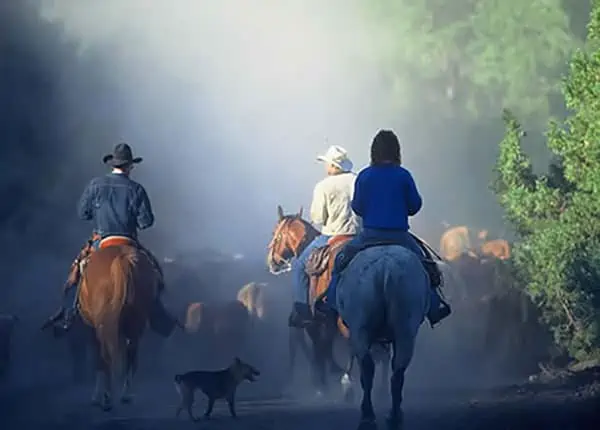
When it’s time to move the cattle to the high country, everybody joins together to ride for the day.
Once they’re on the national forest, the cattle must be moved to new pastures on a regular basis so that the range doesn’t become overgrazed. It takes cowboys to do that work, and only rarely can it be done by vehicle. It’s time to get on your horse and ride!
The Pool Rider
Often the ranchers will “pool” their cattle together and hire one “pool rider” or “cow boss” to supervise the entire herd. Hypothetically, let’s say that six ranchers have grazing permits on the east end of the Grand Mesa. Their herds range from 150 head to 350 head of mother cows per rancher, totaling 1,200 cow/calf pairs. They’ve formed the “East Grand Mesa Cattlemen’s Association” and hired a pool rider to ride the range that summer and keep an eye on the cattle. Periodically the pool rider or “cow boss” will call the ranchers and ask them to all bring horses and help move the cows to the next pasture. For the pool rider, this job can be a slice of heaven. Though satellite phones, hand-held radios, cell phones, and solar panels have inserted modern technology in to his life, it’s a lot like living in the 1870’s. Typically the pool rider lives in a rustic high-mountain cabin witha spring for water and a wood stove for heat, lanterns for light, and propane for the cookstove. He is tasked with the everyday care of the cattle. If a cow eats too much larkspur or other poisonous feed, he’ll rope and doctor her. If an animal gets stuck in a bog, he’ll pull it out. He has to be a high-country veterinarian, fence-builder, range manager, wood-cutter, and horse trainer all in one. He keeps a remuda of 5-6 stout horses for the job, always with one or two new horses in the mix. He will often spend 10-12 hours a day in the saddle. If you are lucky enough to buy a horse that was used 2-3 summers by an honest-to-goodness range cowboy, consider yourself blessed. It will be a great horse.
Identifying Cattle — Brands and Ear Tags
Each rancher brands his cattle with his particular brand so that ownership can be proven. Brands are supervised by the Colorado Brand Board, and one-character brands, such as a “ROCKING R”, were taken long ago. It’s sometimes necessary to buy a brand and have it signed over to you, unless you want a three-character brand of your own design. Colorado brands, such as a “- H”, or “Bar H” are common, and might be used by several different ranchers across the state. The laws read that a brand may not be registered to a new owner unless it is not in use within a two-county radius. So, a rancher in Yuma County on the eastern side of the state and a rancher in Mesa County on the western side of the state could use the same brand, but two ranchers in neighboring Mesa County and Garfield County can’t use the same brand.
In addition, ranchers put ear tags through their cattle’s ears so that a cow or calf can be individually identified. For ease of identification, ranchers agree that, for example, Jim will use white ear tags, Sandy and Ed have red ear tags, and Sally and Tim will have blue ear tags. They write numbers on the tags with a coding system so that, for example, the animal’s year of birth and individual number can be identified. That way a rancher can make decisions on his herd—cow #97-111 is now ten years old, she has had eight good calves, but this year she’s open—should he ship her to slaughter, or try for two or three more years of good calves?
These roundups are a lot of fun, with great camaraderie, lots of saddle time, and beautiful scenery. If you’ve never chased an ornery heifer through oak brush and pinyons with a good cowhorse, it’s a great time. You start to appreciate all the gear that cowboys use, such as good leather chaps to protect your legs from brush tearing at you.
Back at the Ranch — Hay Production
In the meanwhile, back at the ranch, the rancher is busy growing hay to feed his herd over the winter. That’s when the importance of good water rights becomes so clear. Colorado is an arid, dry state, and dryland farming is a risky proposition. Wheat farmers on the eastern plains get away with praying for rain, but it sure doesn’t work to grow grass and alfalfa hay. If you’re going to grow a hay crop, you need to irrigate. (See my article on ranch irrigation systems!)
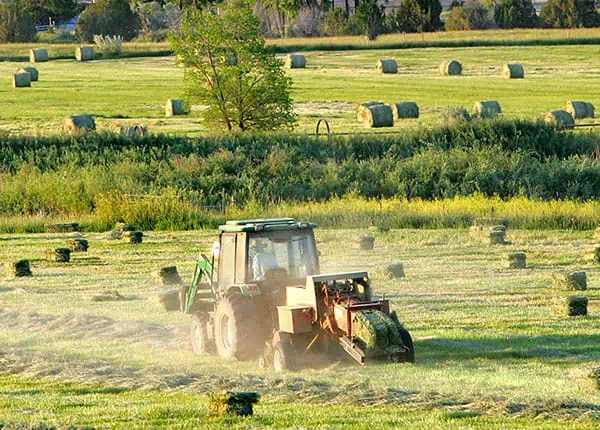
It’s essential to move cattle off hayfields so summer hay production can take place. Colorado water rights work on the doctrine of “prior appropriation.” Whoever has the oldest water rights has the best water rights. I will cover Colorado water rights in a subsequent article. Review my website to look for it. When the grass starts to peek up out of the snow in April, the roots are loading up to push leaves and stalks into the air. Elevation has a lot to do with how much hay you can grow in Colorado–7,000 feet seems to be the dividing line. I’ve already explained that you want to keep animals off the hayfields when the spring comes. If you allow animals to graze on the tender new shoots in the hayfield, it will dramatically affect that year’s hay crop. If you intend to get a good crop, you absolutely must get animals off your fields.
High Country Snow Makes Green Hayfields — Colorado Irrigation Water
As the snow melts in the high mountains, it luckily coincides with the growing season for hay. The first runoff begins to swell up in mid-April, becoming a flood of water in mid-May, and tapering off towards late June. Ranches are fed with a series of ditches that divert water away from creeks and rivers, and the arteries of water flow onto the arid fields. There are many ways to irrigate, including earthen ditches, sideroll systems, pivot systems, gated pipe, and flood irrigation. Check out my article on Colorado irrigation systems for more information. The best growth comes in late May, and most Colorado ranchers are looking to cut their hay in June. There’s a lot of work involved, from building the irrigation system to the daily irrigation chores to actually cutting, baling, and storing the hay. Depending on the irrigation system, the rancher wants to cover his fields with water at least twice before cutting hay, and sometimes it’s possible to cover a field 5 or 6 times before the first cutting, which can result in a great yield. It’s important not to over-saturate the soil, and it’s important to keep the water moving. Alfalfa grows and re-grows for several cuttings, particularly at lower elevations. Alfalfa begins growing again immediately after cutting, and if the ranch is located in a warm zone and has plenty of water, it can be cut several times a growing season. I know farmers around Delta, Colorado, at 4,500 feet, who get four and even five cuttings a year. Grass hay is usually good for at most two cuttings of hay, and often the grass won’t grow the nutritious heads of seeds on the second cutting. If a ranch is located much higher than 6,800 or 7,000 feet, it will usually yield only one cutting of hay a summer. Often it will grow a good thick crop of grass after the first cutting that can be utilized for autumn grazing, but two cuttings a year for high-elevation ranches just isn’t practical.
Typical Colorado Ranch Hay Production
What can you expect per cutting? A really good stand of hay will yield 3-4 tons of hay per acre, but many ranches, if poorly irrigated and not well tended, will yield only a ton or two per acre. If you factor that a cow needs to eat 25-30 pounds of hay a day, and if you start to feed around November 15 and conclude feeding on May 15, that’s 180 days of hay, and a total of 4,500 pounds of feed, or about 2 ½ tons. A ranch that produces 500 tons of hay a year can therefore run about 200 cows. So, if your ranch is well irrigated and productive, you might be able to run 1 cow/calf pair per acre of irrigated ground.
In 2014 parameters, it costs at least $70 a ton to put up hay, after you factor in the cost of the equipment, fertilizer, water, diesel fuel, etc. That does not count the cost of the land or labor. Hay sells for anywhere between $130 and $350 a ton, depending on the quality of the hay and whether it’s put up in 1,400-pound round bales or 65-pound square bales for horse hay. Other factors include the quality of the hay, the grass species included in the bales, alfalfa content, whether or not the hay was put up without rain, etc. High hay prices are great if you’re growing hay for the market or if you have extra hay; high hay prices are terrible if you’re short and you need to buy hay to get your herd through the winter.
Fertilizing the hayfields is extremely important. Though you may have your organic sensibilities, it’s much more difficult to make a paying proposition out of growing organic hay. I’ve done it, and you can double or even triple your yield with a good application of fertilizer. Perhaps I should do more investigation into organic fertilizers, but it simply doesn’t work not to fertilize at all.
Bringing the Cattle Down From the High Country
Ranchers typically try to keep the cattle on the summer range as long as possible, but eventually they need to come down from the mountains. Usually the Forest Service dictates when the cattle must be brought down, but sometimes it’s a function of weather. If a big snowstorm comes in September, the cattle may be down at the gates to winter pasture two months before you’re ready for them.
Most ranchers try to bring their cows down in October or early November. It can be a task to find all the cows. As I write this article on November 24, my neighbor is riding on the Uncompaghre Plateau, trying to round up the last 40 cows that have not come down from the mountains. The ranchers then feed out their hay over the winter. A full-sized cow needs between 25 and 30 pounds of feed per day.
It takes 25-30 pounds of feed per day to sustain a full-sized cow over the winter. Round bales or large square bales (3’x4’x8′) make the daily chore of feeding hay to dozens or hundreds of cattle much easier!
Colorado Cow/calf Operations
Most Colorado mountain cattle ranches are cow/calf operations. The business model revolves around raising a yearly calf crop that will be sold in the fall. Given the fact that many ranchers graze their herds on high-mountain pastures, the ranchers try to breed their cows on a cycle so that the cows start giving birth in late January or February. Calves must be a certain weight before they can stand the rigors of surviving in the wilds, and unless a calf weighs 200-250 pounds before making the trek to the mountains, its chances of surviving the elements and predators over the summer and fall are not nearly as good.
As you might imagine, a Colorado calving shed at 3 a.m. on a February morning is not a warm, comfortable place to be. Most ranchers get up at least a couple of times each night during the calving season to check on their cows, who may start giving birth at any moment. If there are complications in the delivery, a valuable calf can be lost because of inattention. Calf mortality can have consequences in two ways—first, losing a calf that can be sold in the fall for $600-$700 or more, and secondly, should you feed a cow for another year without producing a viable calf? If sold for slaughter, the cow will be sold at a loss. Some years a rancher might get by with losing no calves at all, zero mortality. More commonly, however, a loss of 2-3% in a calf crop is normal, and a bad year might result in as much as 10% mortality. Optimally, the calves will weigh between 600 and 700 pounds in the fall, when they are sold to feedlot operators who will “background” and “finish” the calves for the beef market.

These 600-700 pound steers are being fed in a feedlot in Jetmore, Kansas, for “backgrounding” to gain weight to around 1,000 pounds. They’ll be sent to another feedlot for “finishing” before slaughter.
Selling the Calves in the Fall
Backgrounding is the process of feeding the 600-pound calves to 1,000 pounds or so; “finishing” means fattening the calves on a potent mixture of grain and forage before slaughtering them at 1,200-1,300 pounds. Calves are typically 12-18 months old at the time of slaughter. At the time of this writing, in late 2007, feeder calves are bringing about $1.15- $1.20 a pound, but the price always seems to drop 10 cents right about the time the local ranchers sell their calves.
Lest I forget a very important aspect of any cattle ranch, we must address bulls. Top-quality bulls are essential for any cattle ranch, and they’re bred and bought for their frame and structure, size of calves that they produce, meat yield, temperament, and other factors. Some ranchers choose to artificially inseminate their cows, using semen from top-quality bulls. This is much more labor-intensive—i.e., you end up with your arm up inside every cow that needs to be bred—but it can be more effective than pasture breeding by live bulls. Typically, one bull can cover up to 20 cows, and bulls can be vital up to 10 or 12 years old. After that, their effectiveness at breeding cows wanes and they’re shipped to slaughter. Ranchers who run their cattle in the high country like to keep their bulls younger than five years old, because older bulls leave the herds and “batch up” as bachelor bulls. In the fall, it can be devilishly hard to locate those bulls to drive them home.
In the late fall, many ranchers schedule a veterinarian to come in and check their cows to see if they’re pregnant (called “preg testing”). Cows that are “open”, or not bred, are often shipped to slaughter. Preg testing involves running the cow into a squeeze chute to immobilize the animal, pulling on a long plastic glove, and reaching into the cow’s rectum to palpate the uterus through the uterine wall to see if the cow is growing a fetus. Not a lot of fun, but effective. Most ranchers keep 20-25% of their heifer calves as replacement heifers to replace older, worn-out cows or cows that are open.
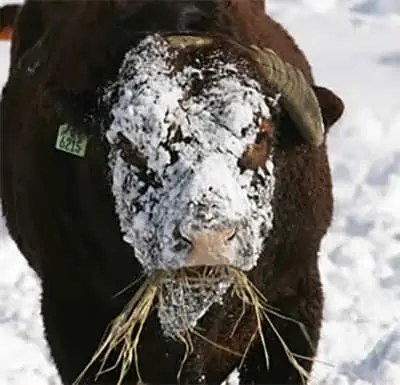
Backgrounding is the process of feeding the 600-pound calves to 1,000 pounds or so; “finishing” means fattening the calves on a potent mixture of grain and forage before slaughtering them at 1,200-1,300 pounds. Calves are typically 12-18 months old at the time of slaughter. At the time of this writing, in late 2007, feeder calves are bringing about $1.15- $1.20 a pound, but the price always seems to drop 10 cents right about the time the local ranchers sell their calves.
Lest I forget a very important aspect of any cattle ranch, we must address bulls. Top-quality bulls are essential for any cattle ranch, and they’re bred and bought for their frame and structure, size of calves that they produce, meat yield, temperament, and other factors. Some ranchers choose to artificially inseminate their cows, using semen from top-quality bulls. This is much more labor-intensive—i.e., you end up with your arm up inside every cow that needs to be bred—but it can be more effective than pasture breeding by live bulls. Typically, one bull can cover up to 20 cows, and bulls can be vital up to 10 or 12 years old. After that, their effectiveness at breeding cows wanes and they’re shipped to slaughter. Ranchers who run their cattle in the high country like to keep their bulls younger than five years old, because older bulls leave the herds and “batch up” as bachelor bulls. In the fall, it can be devilishly hard to locate those bulls to drive them home.
In the late fall, many ranchers schedule a veterinarian to come in and check their cows to see if they’re pregnant (called “preg testing”). Cows that are “open”, or not bred, are often shipped to slaughter. Preg testing involves running the cow into a squeeze chute to immobilize the animal, pulling on a long plastic glove, and reaching into the cow’s rectum to palpate the uterus through the uterine wall to see if the cow is growing a fetus. Not a lot of fun, but effective. Most ranchers keep 20-25% of their heifer calves as replacement heifers to replace older, worn-out cows or cows that are open.
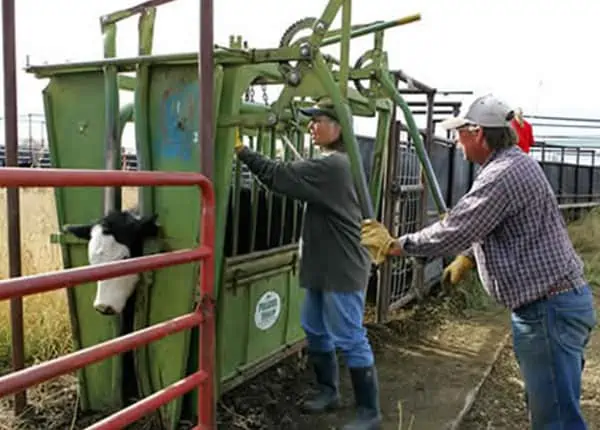
This “replacement heifer” will replace an aged or “open” (unbred) cow. The squeeze chute helps keep the animals still while they’re being vaccinated and de-wormed, which takes place in the fall. Note the “bald face”. That connotes a cross between a Hereford and an Angus, which buyers like for their “hybrid vigor”.
Popular breeds of beef cattle in Colorado and the Rocky Mountain region include black Angus and red Angus (probably the two most popular breeds), Hereford (third most popular), and Continental breeds such as Charolais, Gelbvieh, Simmental, and Limousin. Some feedlot buyers look for hybrid cattle, such as a whitefaced black calf, showing that it is a cross between an Angus and a Hereford. They believe that hybrid cattle are hardier than purebred cattle.
In other areas, ranchers are switching over to a fall calving season, so that they avoid the scenario of selling their calves at a time when the market is flooded with many thousands of cattle raised on a similar schedule. I know several ranchers who specialize in raising registered cattle that are sold as breeding stock nationwide.

This heifer is a registered Angus out of top bloodlines. She is about to be sold at a Colorado production sale, where she will bring $3,000-$5,000, about 3 to 5 times the market price for unregistered cattle.
Raising Registered Cattle
Despite the greatly increased burden of record-keeping and paperwork, it can be substantially more profitable than selling cattle for the beef market. Still other ranches specialize in buying feeder calves from cow/calf operations and raising the steers to close to a slaughter weight, so that they require only a month or two of fattening on grain before slaughter.
The Economics of Colorado Cattle Ranching
Please note that this is the typical business model for mountain cow/calf operations. Ranchers on the eastern plains areas, such as La Junta and Brush, might have an entirely different business model. Many of the eastern plains ranchers rely on dryland pastures year-round, with little or no hay growing or irrigation systems. These operations require thousands of acres to graze cattle, often 40 acres or more per cow/calf unit. Consequently, acreage in those plains areas, which don’t have irrigation water or gorgeous mountain views, might sell for $250-$1,000 an acre, whereas irrigated mountain ranches might sell for many thousands of dollars an acre.
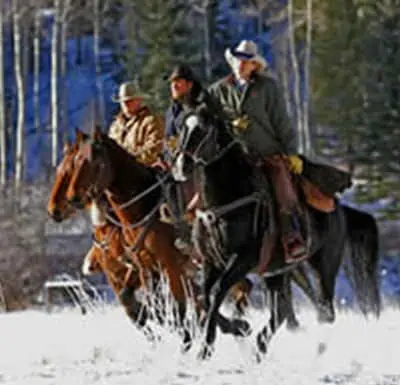
If you’re looking at a cattle ranch in a particularly scenic area with good recreational amenities such as elk and mule deer hunting, fly-fishing on beautiful trout streams, skiing, snowmobiling, whitewater rafting, and other such perks, the cost of the land won’t pencil out as a profitable ranch. The play on such an acquisition is lifestyle and investment. Historical averages will show that Colorado mountain properties are gaining value year after year, and the bonuses of a yearly return plus the tax advantages of running a producing agricultural operation can be significant.
So there’s a snapshot of Colorado cattle ranching. Of course, entire university courses of study are based on this subject, but I hope this article gives you an understanding of this important part of rural Colorado lifestyle. If you’re in the market to buy a Rocky Mountain cattle ranch, I think I’ve demonstrated ample knowledge that I know what to look for. Call me if you’re looking to buy or invest, and I’ll get to work on finding you your dream cattle ranch.
Ranch Horses for Sale
Paints, quarter horses, draft crosses, Missouri foxtrotters, Arabians. Mountain broke trail horses for hunting and trail riding, ranch geldings, and prospects. Our website link at www.mountaintrailhorses.com is where you can find our horses for sale.

